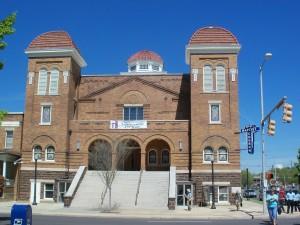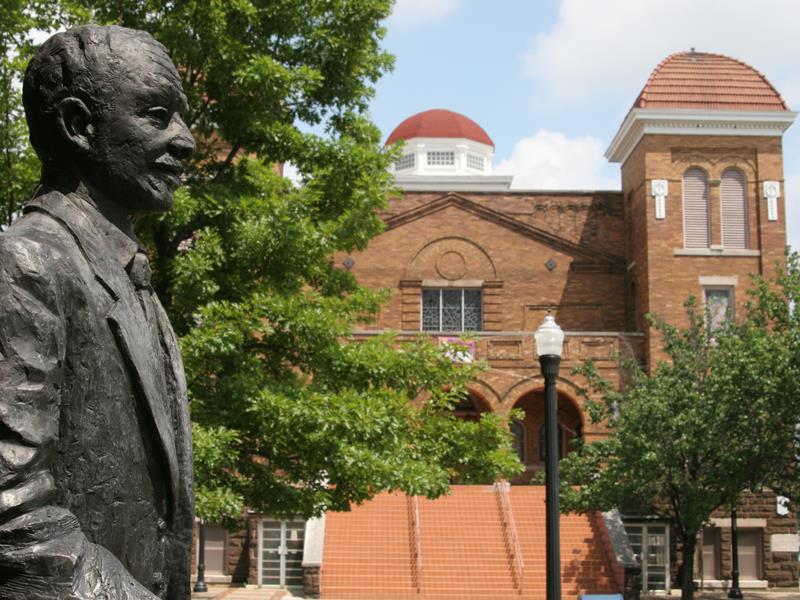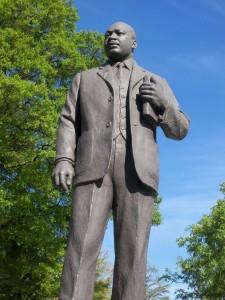The Birmingham Civil Rights District encompasses downtown and includes significant locations along the 1963 Civil Rights march routes
As many people of a certain age remember, some of the most vivid images of the turbulent 1960s were black demonstrators being attacked by police dogs and fire hoses in the streets of Birmingham, Alabama. The non-violent protesters, led by ministers including Dr. Martin Luther King Jr. and the Rev. Fred Shuttlesworth, were pressuring city leaders to overturn repressive segregation laws that divided blacks and whites.
Today the battlefields trod by those foot soldiers of the civil rights movement have been turned into shrines visited by tourists from all over the world. Points of interest in Birmingham’s Civil Rights District, on the edge of downtown, are within easy walking distance of each other along the Birmingham Civil Rights Heritage Trail.
Birmingham Civil Rights Institute
As someone who recalls watching these struggles on TV newscasts, I found Birmingham’s museum exhibits, outdoor monuments and trail markers a fascinating look back at recent U.S. history. The statue of Dr. King in Kelly Ingram Park reminded me of a sweltering summer day at a Chicago rally where I stood within feet of the civil rights icon as he spoke under the shade of umbrellas held by aides.
For a glimpse into the drama of that era, visitors to the Birmingham Civil Rights Institute (facing Kelly Ingram Park) will see black-and-white footage of King’s 1963 “I Have a Dream” speech at the Lincoln Memorial in Washington, D.C. Exhibits include the jail cell where King wrote his famous “Letter from the Birmingham Jail” that urged religious bystanders to become active in the movement. A statue in front of the Institute honors Shuttlesworth, pastor of Bethel Baptist Church, who endured beatings and a house bombing while a leader in the Birmingham marches.
The Civil Rights Institute chronicles injustices that blacks faced in the South and Birmingham in particular. The most graphic photo depicts a public lynching. On display are a Ku Klux Klan robe and a burnt cross from a yard of a Huntsville house shared by a white woman and black man. Vintage TVs show film clips of demonstrators being doused by powerful hoses and held at bay by dogs.
Other exhibits show examples of racial stereotypes in popular culture, such as advertisements and products that relied on images of happy overweight “mammy” figures (like Aunt Jemima), minstrel faces and blacks eating watermelons. Museum-goers also witness the realities of segregated lunch counters, restrooms, drinking fountains, theaters and bus station waiting rooms. They learn about baseball’s Birmingham Black Barons, a Negro American League team that Willie Mays led to a championship in 1948.

Birmingham’s 16th Street Baptist Church was the scene of a deadly 1963 bombing.
A turning point in the nation’s civil rights movement was the Sept. 15, 1963 bombing of a Birmingham black church that killed four girls changing into their choir robes in the church basement. Perpetrated by Klansmen, the crime shocked the world and generated support and sympathy for the movement. The bombing of the 16th Street Baptist Church, right across the street from the Civil Rights Institute, was one of many such racially directed acts from the late 1940s to mid-1960s that gave Birmingham the nickname “Bombingham.”
Exhibits in the church and Civil Rights Institute describe the horrific crime that buried the girls (ages 11 to 14) in rubble; another girl lost an eye and more than 20 other people were injured. The brown-brick church, built in 1909 and designated a National Historic Landmark, was an epicenter of the civil rights movement. It is open for tours and welcomes visitors to Sunday services. “Angels of Change,” a video shown in the sanctuary, depicts the bombing, aftermath and prosecution of the criminals years later. At the back of the sanctuary is the stained-glass Wales Window, a memorial gift of a black crucified Christ from the people of Wales. Financial contributions for restoration of the damaged church poured in from around the world, and it reopened for Sunday services on June 7, 1964.
Kelly Ingram Park
The Greater Birmingham Convention & Visitors Bureau can arrange for step-on guide services for groups who wish to tour the downtown Civil Rights District and other neighborhoods that had connections to the movement. (The city of Birmingham today is 80 percent black, while the suburbs are mostly white.).
Kelly Ingram Park was the staging ground of 1960s demonstrations, and during a 1992 renovation several civil rights-related sculptures were installed, including the statue of Martin Luther King. A much-photographed sculpture on the park’s Freedom Walk shows three ministers kneeling in prayer during a march where they were met by police dogs and billy clubs. One of the figures is A.D. King, brother of MLK. The sculpture is one of several stops on the audio wand tour available from the Civil Rights Institute. Other sculptures depict teens in jail (many marchers were high school students) and ferocious police dogs that seem to jump out at passersby.
Kelly Ingram Park also has some of the informational photo signs that mark spots where events took place. Renee Kemp-Rotan, administrative assistant to the mayor for capital projects, said photos were chosen from the 6,000 never-before-seen negatives recently uncovered by an intern in storage boxes at the Birmingham News.
Kelly Ingram Park is part of the Fourth Avenue Historic District, once a thriving black retail/entertainment district and still home to many minority-owned businesses. Of special interest to tourists is the Alabama Jazz Hall of Fame, housed in the former Carver Theatre, a movie theater for blacks. Eddie Kendrick Memorial Park, just down the block, honors the Birmingham native and lead singer for the Temptations, the Motown group celebrated for its fine-tuned choreography.
The Historic Fourth Avenue Visitor Center offers a walking tour map and can give a slide presentation on request. It also can arrange guided walking tours.
For more information, contact the Greater Birmingham CVB, 800-458-8085, www.birminghamal.org.
–Story and Photos by Randy Mink







